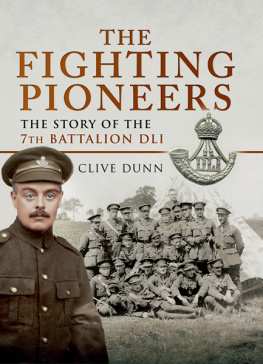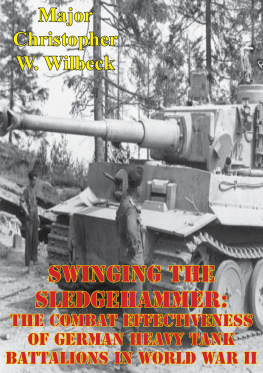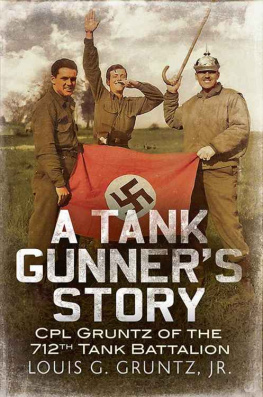
This edition is published by PICKLE PARTNERS PUBLISHINGwww.picklepartnerspublishing.com
To join our mailing list for new titles or for issues with our books picklepublishing@gmail.com
Or on Facebook
Text originally published in 1995 under the same title.
Pickle Partners Publishing 2015, all rights reserved. No part of this publication may be reproduced, stored in a retrieval system or transmitted by any means, electrical, mechanical or otherwise without the written permission of the copyright holder.
Publishers Note
Although in most cases we have retained the Authors original spelling and grammar to authentically reproduce the work of the Author and the original intent of such material, some additional notes and clarifications have been added for the modern readers benefit.
We have also made every effort to include all maps and illustrations of the original edition the limitations of formatting do not allow of including larger maps, we will upload as many of these maps as possible.
A STUDY IN LEADERSHIP: THE 761ST TANK BATTALION AND THE 92D DIVISION IN WORLD WAR II
By
MAJ Lenora A. Ivy, USA
TABLE OF CONTENTS
Contents
TABLE OF CONTENTS
ABSTRACT
This thesis evaluates leadership in the 761st Tank Battalion and the 92d Division, two black units during World War II. Leaders in each unit were evaluated on their ability to use the following leadership model: technical skills (job experience, technical competence, and the ability to correlate facts into meaningful information); conceptual skills (vision and the ability to task organize to accomplish the mission); and interpersonal skills (job related standards and the ability to foster mutual trust and respect) to influence combat effectiveness.
The analysis showed that the leaders in the 761st Tank Battalion demonstrated skills in the leadership model effectively and especially were successful in demonstrating interpersonal skills. Its successful combat record supports that its leaders were effective. On the other hand, the leaders in the 92d Division failed to properly demonstrate the skills of the leadership model. The lack of interpersonal skills used by leaders in the division (developing trust and mutual respect) was the major cause of the units combat failures.
This study showed that despite negative beliefs about Negro soldiers there were some leaders who effectively applied interpersonal leadership skills in the interest of mission accomplishment.
ACKNOWLEDGMENTS
I am thankful to my family and friends who throughout the school year provided me with encouragement and assistance in completing this project. Thanks to my staff group who made this year an enjoyable one even with the added work of this thesis. A special thanks to my parents, especially my father an Army veteran of three wars, who gave me unwavering support in my research and in my school work.
I would like to thank the 761st Tank Battalion Monument Memorial Committee, the U.S. Army Military History Institute, the Patton Museum of Armor and Cavalry, the Historians at the National Archives Reference Branch, and the staff at the Combined Arms Research Library for their professionalism and valued assistance.
Finally, I would like to thank my committee members for their time, assistance, and patience in guiding me.
CHAPTER 1INTRODUCTION
History provides the military professional with a perspective from which to evaluate his/her current situation. The in-depth study of historical examples also affords military professionals a safe vantage point from which to apply lessons learned. Leadership is no exception. The Armys keystone leadership manual, FM 22-100, quotes B. H. Liddell Hart: The practical value of history is to throw the film of the past through the material projector of the present onto the screen of the future. {1} World War II, is a favorite and an appropriate historical backdrop to analyze a broad spectrum of studies. As is the case here where World War II was the backdrop that this thesis looked at leadership in two black combat units involved in combat in the European Theater.
Leadership in the Army during World War II was especially difficult in the racist social and political environment surrounding Negroes equal rights, and the employment of Negro troops in the military. Today as the likelihood increases for American military leaders to become leaders of multicultural and multinational forces because of the United States involvement in operations other than war (OOTW), leaders can learn from historical examples that appropriate leadership skills will ensure effective mission accomplishment, especially when leading different cultures and races. Two authors writing on leadership believed:
Effective leaders are sensitive to the changing conditions of their group and flexible in adapting their behavior to new requirements.... Leadership is viewed as the performance of those acts which help the group achieve its preferred outcomes... nearly every conception of leadership contains the notion that a true leader exerts more influence on the group and its activities than does the average members. {2}
The Army has long recognized the relationship between leadership and combat effectiveness. The Armys leadership manual states that leadership is the most important element in combat effectiveness. A good leader will cause a unit to be successful; successful in combat and other tasks. In the military, successful mission accomplishment is determined by how well a unit will meet its training requirements or its combat objectives. Success in combat is easily determined by the end state. Effective leaders, and that which makes leaders successful, however, is not easily defined in concrete measures like combat effectiveness. So the dilemma becomes: What must the leader do to be effective? The journey to uncover a sure method of effective leadership is and has been the focus of many studies by psychologists, social scientists, professional scholars, military leaders, and other practitioners today and throughout history. What is the best method to lead and motivate people? Why are some leaders more successful than others? These two questions were the focus of the analysis of this thesis as they related to two black units in World War II.
The Army has been, and continues to be, a reflection of American society. Therefore, it is not surprising that the leadership principles and theories used to ensure effective leadership in the military were primarily adapted from leadership theories in the civilian sector. As leadership theories were adapted, similarly, in 1940 white societys beliefs and attitudes about Negroes and their potential competence as soldiers were also adapted by the military.
The employment of Negro troops in the World War II Army was a reflection of white societys social practices. The Army inherited its problems with race relations, but was forced to address the race issue that the American society had created. There were generally two views. There were many people who saw the use of Negro troops in an equal status as a dangerous policy change threatening the status quo. On the other hand, there were those who felt that the Army should have eliminated any racial distinctions and felt the use of Negroes in World War II was overly conservative and highly ineffective. {3} The Armys policy as stated by Ulysses Lee, an author, was to use ten percent of Negroes in the Army as a figure, because Negroes constituted ten percent of American society. Yet on the eve of the United States participation in World War II and premobilization, the employment of black soldiers in the Armed Forces was still an unresolved issue--unresolved since black soldiers participation in World War I.








